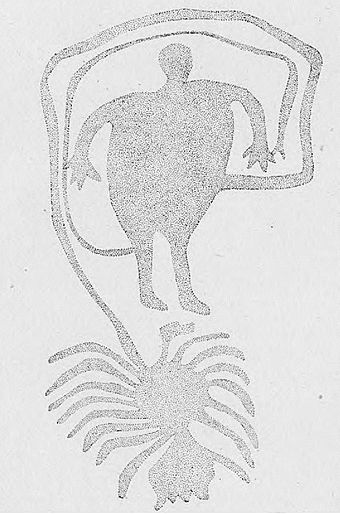Spider Cave facts for kids
Quick facts for kids |
|
|
Spider Cave
|
|

"Spiderman" illustration from Hinsdale, 1925
|
|
| Location | at the base of Burnt Bluff, near Fayette, Michigan |
|---|---|
| Area | less than one acre |
| NRHP reference No. | 71001021 |
| Added to NRHP | April 16, 1971 |
Spider Cave, also called Burnt Bluff Cave, is a special place in Michigan. It's an archaeological site, which means it's a spot where people find old things from the past. You can find it on the Garden Peninsula, close to Fayette. This cave was added to the National Register of Historic Places in 1971 because of its importance.
Contents
What is Spider Cave?
Spider Cave is a cave made by water. It sits about 20 feet (6 meters) up from the bottom of Burnt Bluff. This bluff is a tall limestone cliff, about 150 feet (46 meters) high, right by the water of Big Bay de Noc. The bluff has many caves, some made by wind and some by water. Spider Cave was formed around 4,000 years ago. It is about 90 feet (27 meters) long and 30 feet (9 meters) deep.
Amazing Cave Paintings
Inside Spider Cave and on the rocks near its entrance, there are four ancient rock paintings called pictographs. The most famous one shows a person connected to what looks like a spider. They are linked by a swirly line, like an umbilical cord. This painting is often called the "Spider Man."
The colors used for the "Spider Man" painting are shades of red-violet and blue-violet. These colors likely came from colorful minerals. They were probably mixed with grease and other things like fish eggs or animal glue to help them stick.
Why the Paintings are Fading
Sadly, these amazing pictographs are slowly fading away. This happens because of natural things like wind and water wearing them down. Also, some tourists used to pour water on the images to see them better, which made them fade faster. By 2009, only two of the "spider legs" on the "Spider Man" image were still easy to see. The rest were hidden under moss and salt buildup.
The History of Spider Cave
People likely first lived in the caves on Burnt Bluff around 1200 BC. There were at least 165 caves and shelters that people used. Scientists have many ideas about why this place was so important to the people who lived there. Some think it was a place for special ceremonies, a winter home, or even a burial site. But no one knows for sure.
Early People and European Settlers
The earliest people recorded in the Burnt Bluff area were the Noquet people. They lived there before Europeans arrived, possibly as early as the 1500s. Today, Ojibwe people in the area still trace their family history back to the Noquet. These communities have many stories about Burnt Bluff and its paintings.
In 1867, a large part of the Garden Peninsula was given to the Jackson Iron Company. This company planned to build factories in Fayette. Starting in the 1880s, different private owners bought the land around Spider Cave.
Discovering the Cave's Secrets
The first time the pictographs in Spider Cave were written about was in a book called Primitive Man in Michigan. Later, in 1963, two scientists, Charles E. Cleland and G. Richard Peske, dug up parts of the cave. They found many old tools and weapons, mostly Woodland period arrowheads.
Most of these arrowheads had broken tips. This suggests they were shot into the cave from outside and hit the back wall. Because there were so many arrowheads and not many other things usually found where people lived, scientists think Spider Cave was not a regular home.
Spider Cave Today
Some of the private owners, Ruth and Henry Lang, bought the land in 1947. They even advertised the Spider Cave pictographs as a place for tourists to visit. In the 1970s, the State of Michigan bought the land around Burnt Bluff. Now, it is part of Fayette Historic State Park. To protect the cave and its ancient art, Spider Cave is now closed to the public.
Images for kids




